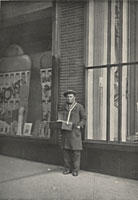 The Chinese people who arrived in the Netherlands from around 1900 onwards were nearly all seafarers and, in particular, stokers. Yet the Dutch did actually not see much of them. After all, they worked on the steamships of the big shipping companies, such as KNSM, Oceaan and SMN. Between contracts, they resided at boarding houses in Rotterdam and Amsterdam. In Rotterdam, where, for a long time, the Chinese minority had been far larger than in Amsterdam, the Chinese population concentrated itself on the Katendrecht.
The Chinese people who arrived in the Netherlands from around 1900 onwards were nearly all seafarers and, in particular, stokers. Yet the Dutch did actually not see much of them. After all, they worked on the steamships of the big shipping companies, such as KNSM, Oceaan and SMN. Between contracts, they resided at boarding houses in Rotterdam and Amsterdam. In Rotterdam, where, for a long time, the Chinese minority had been far larger than in Amsterdam, the Chinese population concentrated itself on the Katendrecht.
In Amsterdam, the Chinese community lived in and around the Binnen Bantammerstraat.
The Chinese seamen were greatly favoured by the shipping companies because of their low wages; in 1911 the Chinese sailors were kept in reserve as strike-breakers during the major seaman's strike.
The Chinese sailors tended to be signed up as a group per ship. The contact person was simply called 'number one', frequently this was the 1st stoker and he was usually the only one in the team who spoke a bit of English or, more rarely, a bit of Dutch. The manager of the boarding house usually acted as the shipping master. He entered into a contract with number one, who ensured that the rest of the group was available. The pay was around 70% of a Dutch sailor's earnings. However, 90% of these wages went to the shipping master for mediation, board and lodging and credit.
The Dutch public only really became familiar with the Chinese when resourceful laid-off seamen began to sell peanut biscuits on the streets in 1931. The economic crisis had left the stokers stuck unemployed in their boarding houses. The shipping industry's transition from steam to diesel made their prospects even bleaker. The pauperisation of these poor seafarers, who were already rather impoverished, and even hunger hit them hard. They had no legal status or support. At the time, the Dutch government actively took steps to involuntarily repatriate them to China. It is believed that during the 1930s one thousand Chinese people, among whom the elderly and sick, were forcibly repatriated to their homeland.
Read how the Chinese community was able to secure a lasting postion in Amsterdam.
View some photos of the Chinese community in Amsterdam by Ab Koers.
